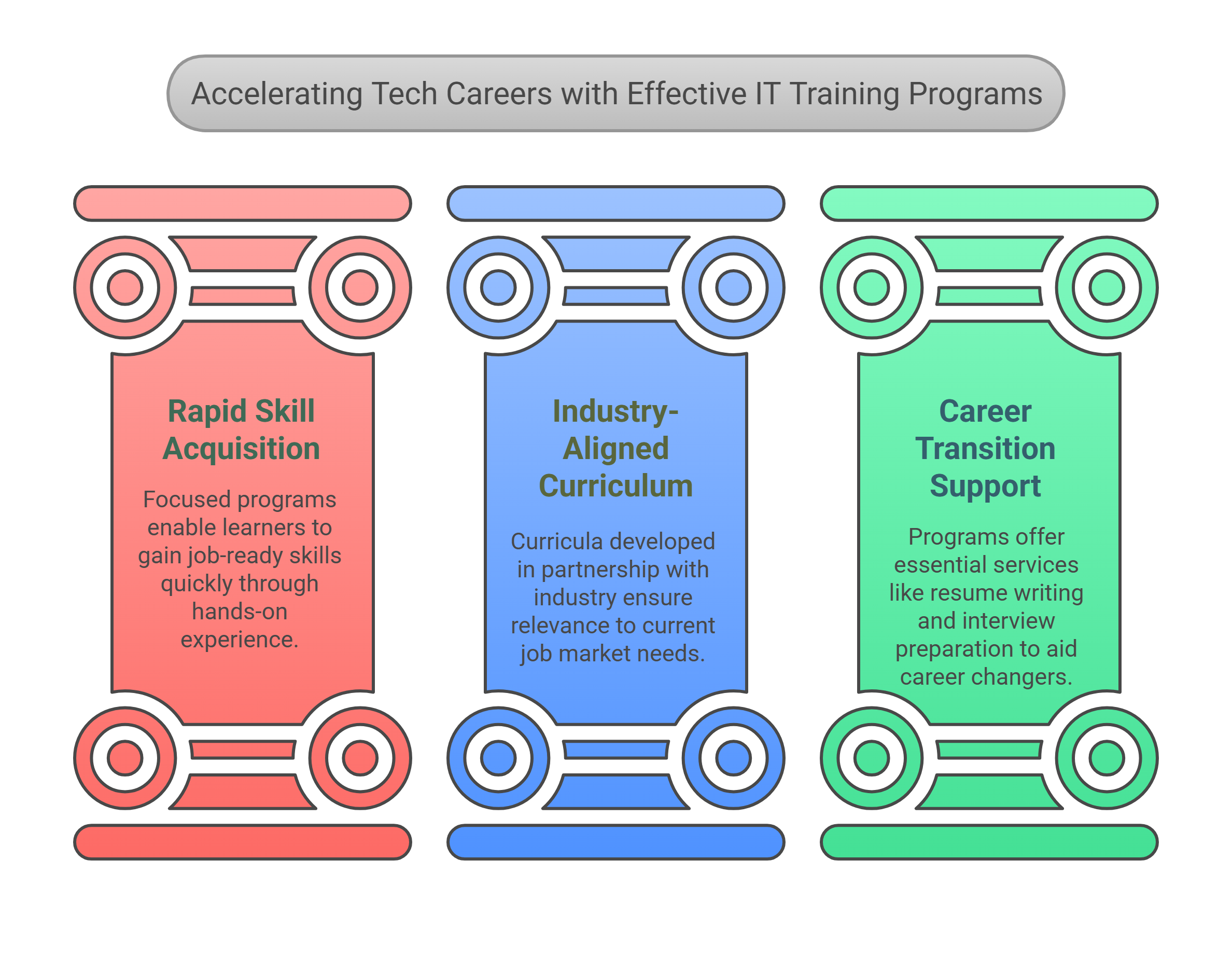
Bridging the Skills Gap:
How IT Training Programs Can Help
The tech industry is facing a paradox: while companies desperately seek qualified talent, millions of potential workers remain on the sidelines, lacking the specific skills needed to fill these roles. According to CompTIA's Workforce and Learning Trends report, 80% of IT hiring managers report significant challenges in finding candidates with the right technical skills. This disconnect between available jobs and qualified workers represents a growing skills gap that threatens innovation and economic growth.
Understanding the Skills Gap
The skills gap in technology isn't just about a shortage of workers – it's about a mismatch between the skills employers need and the qualifications job seekers possess. According to McKinsey's Global Survey, 87% of companies are currently facing skills shortages or anticipate encountering them in the next few years.
Perhaps more telling, Deloitte's 2023 Global Human Capital Trends study found that 74% of organizations identify reskilling their workforce as critical for their success, yet only 10% feel ready to address this challenge.
Why IT Training Programs Matter
In today's rapidly evolving digital landscape, traditional education alone often isn't enough to prepare workers for tech careers. IT training programs offer several distinct advantages:
Rapid Skill Acquisition
Unlike traditional four-year degrees, focused IT training programs can equip learners with job-ready skills in months rather than years. These programs emphasize practical, hands-on learning that directly translates to workplace requirements.
Industry-Aligned Curriculum
Quality IT training programs work closely with industry partners to ensure their curriculum matches real-world needs. This alignment means graduates possess the exact skills employers are seeking, from cloud computing to cybersecurity.
Career Transition Support
For career changers or those looking to update their skills, IT training programs often provide crucial support services like resume writing, interview preparation, and job placement assistance.

Types of Effective Training Solutions
The landscape of IT training has evolved to meet diverse learning needs:
Bootcamps
Intensive, short-term programs that focus on specific tech stacks or roles, bootcamps have gained recognition for their ability to produce job-ready graduates quickly. They're particularly effective for career changers who need to acquire new skills rapidly. Many popular bootcamps run 5 days and advanced certifications may run for 2 weeks.
Corporate Training Programs
Many companies have developed in-house training initiatives to upskill their existing workforce. These programs help organizations address their specific skills gaps while providing career growth opportunities for employees.
Online Learning Platforms
Flexible, self-paced online courses allow learners to acquire new skills while maintaining their current responsibilities. Platforms often offer certification preparation and practical projects that demonstrate competency to potential employers.

Making Training Programs Work
For IT training programs to effectively bridge the skills gap, several key elements must be present:
Practical Application
Theory alone isn't enough. Successful programs incorporate real-world projects, internships, or apprenticeships that allow learners to apply their skills in practical settings.
Ongoing Assessment
Regular evaluation of both learner progress and program effectiveness ensures training remains aligned with industry needs and produces qualified candidates.
Industry Partnerships
Strong connections between training providers and employers create direct pathways to employment and ensure curriculum relevance.
The Road Ahead
As technology continues to evolve at an unprecedented pace, the importance of effective IT training programs will only grow. Organizations that invest in training and development today are better positioned to address future skills gaps and maintain competitive advantage.
To truly bridge the skills gap, stakeholders across the ecosystem must work together:
Employers need to clearly communicate their skills requirements and support training initiatives
Training providers must stay current with industry trends and maintain high standards of instruction
Learners must commit to continuous learning and professional development
Policymakers should support and incentivize workforce development programs

Final Words
The technology skills gap represents both a challenge and an opportunity. While the mismatch between available talent and needed skills poses significant challenges for organizations, it also creates opportunities for individuals willing to invest in their professional development. Through well-designed IT training programs, we can build bridges between talented individuals and the growing number of technology careers awaiting them.
By focusing on practical skills, maintaining industry alignment, and providing comprehensive support services, IT training programs can play a crucial role in addressing the skills gap and preparing workers for success in the digital economy.

Frequently Asked Questions About IT Training Programs
How long does it typically take to complete an IT training program?
The duration varies significantly based on the program type and your learning goals. Bootcamps are the fastest and typically run 1-2 weeks per certification full-time or 4-8 weeks part-time. With a bootcamp, you must be ready to eat, sleep, train, lab and review long hours every day. Certificate programs might also take 3-6 months, while comprehensive career transition programs could take up to a year. Self-paced online courses offer the most flexibility, allowing you to learn on your own schedule. It all depends on your preference and learning style.
How much do IT training programs cost?
Costs range widely from free online courses to premium bootcamps costing $15,000 or more. Many programs offer flexible payment options, including:
· Income Share Agreements (ISAs) where you pay after securing a job
· Payment plans with monthly installments
· Scholarships for underrepresented groups
· Employer tuition reimbursement programs
Do I need prior technical experience to start an IT training program?
Most entry-level programs don't require previous technical experience. However, you should be comfortable using computers and have strong problem-solving skills. Many programs offer preparatory courses to help beginners build foundational knowledge before starting the main curriculum.
Which IT skills are most in-demand right now?
· Current high-demand skills include:
· Cloud computing (AWS, Azure, Google Cloud)
· Cybersecurity
· Data analytics and data science
· Full-stack web development
· DevOps
-
· Artificial Intelligence and Machine Learning
However, the specific skills you should focus on depend on your career goals and local job market demands.
How do I choose the right IT training program?
Consider these factors when selecting a program:
· Learning format (in-person, online, hybrid)
· Program reputation and outcomes data
· Job placement rates and career support services
· Cost and available financing options
· Time commitment required
· Curriculum alignment with your career goals
· Industry partnerships and networking opportunities
Will an IT training program guarantee me a job?
While no program can guarantee employment, many reputable programs have high job placement rates. You can look for programs that:
· Share verified employment outcomes
· Offer career services and job search support
· Have strong employer partnerships
· Provide networking opportunities
· Help build your portfolio of practical projects
Can I complete an IT training program while working full-time?
Yes, many programs offer flexible options for working professionals:
· Part-time schedules
· Evening and weekend classes
· Self-paced online learning
· Hybrid formats combining online and in-person sessions Choose a format that realistically fits your schedule and learning style.
How do employers view IT training program certificates versus traditional degrees?
Many employers recognize alternative credentials, especially from respected training program or a well known certification. What matters most is your ability to demonstrate practical skills through:
· Portfolio projects
· Technical assessments
· Industry certifications
· Real-world problem-solving abilities Some employers may still prefer degrees for certain roles, but hands-on experience and proven skills often matter more than traditional credentials.
How can I ensure the training program I choose is legitimate?
Research these aspects:
· Verified student reviews and testimonials
· Employment outcome data
· Accreditation or industry recognition
· Partnerships with known companies
· Transparency about costs and requirements
· Quality of curriculum and instructors
· Track record of successful graduates
What support should I expect from an IT training program?
Quality programs typically offer:
· Technical mentorship
· Career coaching
· Resume and portfolio review
· Interview preparation
· Job search guidance
· Networking events
· Alumni community access
· Ongoing learning resources
Remember that your success in any program largely depends on your commitment and effort. Choose a program that aligns with your goals and learning style, and be prepared to invest significant time and energy in your learning journey.
Mike G.
IT Certification Jump
 Add Row
Add Row  Add
Add 



